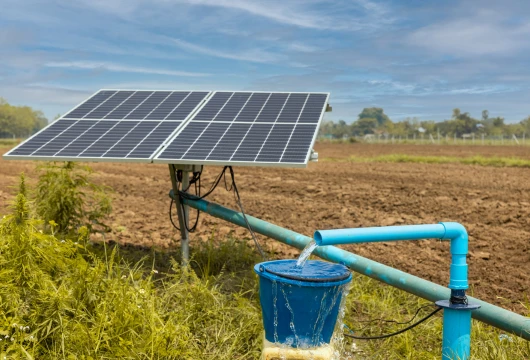Building a green economy that’s fair, inclusive, and future-ready : here’s how India can make its clean energy shift just and equitable.
The world is racing toward a greener future — but not everyone starts from the same place. For developing countries like India, the challenge of decarbonizing the economy isn’t just about switching from coal to clean energy. It’s about doing it without leaving anyone behind.
This is where the concept of a “Just Transition” becomes crucial. It’s not merely a climate slogan — it’s a social and economic imperative that ensures workers, communities, and marginalized groups are supported as we shift from carbon-intensive sectors to sustainable industries.
India, home to over 1.4 billion people, stands at a critical juncture. With net zero by 2070 as its national goal and rapid energy transitions already underway, ensuring that this shift is just, inclusive, and equitable will define not just India’s climate success but also its moral leadership in the Global South.
Let’s explore 7 practical hacks that India — and similar developing nations — can adopt to make the green transition a truly just transition.
1. Reskill and Upskill the Workforce for Green Jobs

Why It Matters
The shift from fossil fuels to clean energy will inevitably disrupt traditional employment patterns. India’s coal mining, power generation, and automobile industries together employ millions. As solar, wind, EVs, and hydrogen sectors grow, new jobs will emerge — but they require different skill sets.
Without strategic upskilling, this transition could result in mass unemployment and social unrest, undermining public support for climate goals.
Hack: Create a National Green Skill Mission 2.0
India already has a Skill India Mission, but it needs a Green Skill vertical focused on:
- Reskilling coal workers into roles in solar installation, battery maintenance, or waste management.
- Integrating green modules into Industrial Training Institutes (ITIs) and polytechnics.
- Collaborating with universities, NGOs, and industry to co-design curricula focused on circular economy, ESG compliance, and green entrepreneurship.
Case in Point
Germany’s “Coal Commission” model retrained over 20,000 workers while phasing out coal. India can replicate this success through localized Just Transition Skill Hubs in coal-heavy states like Jharkhand, Chhattisgarh, and Odisha.
Outcome
Empowering workers with green skills transforms the transition from job loss to job evolution.
2. Diversify Regional Economies Beyond Fossil Fuels
Why It Matters
Entire districts in India depend economically on coal mines or thermal power plants. When these close, communities lose not just jobs but also local revenue, infrastructure support, and identity.

Hack: Build Economic Resilience Through Green Clusters
India should promote “green diversification” — attracting new industries such as:
- Renewable energy manufacturing hubs (solar panels, EV components)
- Sustainable tourism and agroforestry enterprises in former mining belts.
- Bio-economy ventures such as bamboo-based products, ethanol, or green hydrogen parks.
Case in Point
South Africa’s “Just Energy Transition Investment Plan (JET-IP)” includes regional diversification funding for coal-dependent areas.
India can emulate this via a Just Transition Fund jointly supported by CSR initiatives, international climate finance, and public budgets.
Outcome
Communities move from dependency on extractive industries to self-reliant, diversified, and resilient local economies.
3. Empower Rural Livelihoods Through Decentralized Clean Energy

Why It Matters
For India, where nearly 60% of the population still relies on agriculture and allied sectors, energy access directly affects livelihoods, productivity, and equity.
A top-down energy model often misses the potential of decentralized, community-owned systems — like microgrids or solar cooperatives — that democratize clean power.
Hack: Promote Energy Democracy
Encourage models such as:
- Solar pump schemes for small farmers (expanding KUSUM).
- Biogas and bioenergy units run by rural cooperatives.
- Community-owned renewable microgrids that ensure local power reliability.
Case in Point
In Bihar, the Husk Power Systems initiative uses rice husk biomass to run microgrids across 200+ villages — powering shops, schools, and small factories sustainably.
Outcome
Energy democratization enables inclusive economic growth, reduces rural migration, and builds local resilience — aligning with the heart of a just transition.
4. Mobilize Green Finance That Prioritizes Inclusion
Why It Matters
Climate finance is often directed toward large corporations and infrastructure projects, while small enterprises, women entrepreneurs, and farmers find it difficult to access funds for sustainability efforts.
A just transition demands financial justice — making sure green finance reaches the last mile.

Hack: Design Inclusive Green Financial Instruments
- Launch Micro Green Bonds targeting MSMEs and cooperatives.
- Offer interest subsidies or tax breaks for green business models.
- Integrate social criteria (S in ESG) in lending frameworks.
- Encourage blended finance models that combine private capital with public guarantees.
Case in Point
The Energy Efficiency Financing Platform (EEFP) in India already bridges energy-saving projects with investors. Expanding it to small-scale renewable or recycling ventures could revolutionize rural and urban sustainability funding.
Outcome
When finance is accessible and equitable, green transition becomes not just feasible, but transformative for local communities.
5. Embed Social Dialogue and Worker Participation

Why It Matters
Top-down policymaking often sidelines the voices of workers, unions, and communities most affected by transitions. Without participation, policies risk being viewed as elitist or externally imposed.
Hack: Institutionalize “Just Transition Councils”
These councils should include:
- Government representatives (central and state).
- Trade unions and industry associations.
- Civil society groups, youth, and academia.
Their mandate:
- Assess social impact of decarbonization projects.
- Develop compensation, retraining, and relocation plans.
- Ensure transparent grievance redressal mechanisms.
Case in Point
The European Green Deal mandates social dialogue at every stage of energy transition. India can adapt this by embedding Just Transition Cells within state environment and labor departments.
Outcome
Democratizing decision-making builds trust, legitimacy, and smoother policy adoption.
6. Integrate Just Transition into Education and Research
Why It Matters
India’s higher education system produces millions of graduates yearly — yet sustainability and climate literacy are still nascent in most curricula. To future-proof the workforce, climate justice education must be mainstreamed.

Hack: Institutionalize Climate Education Across Disciplines
- Integrate Just Transition modules into management, engineering, and social sciences programs.
- Fund interdisciplinary research on regional transition pathways.
- Incentivize universities to partner with industries on green innovation.
- Establish centers of excellence for climate resilience and sustainable livelihoods.
Case in Point
The Climatora e-skill initiative is a step in the right direction. Scaling this across public universities could create a generation of climate-literate professionals.
Outcome
Education becomes the engine of equity, preparing youth not only for green jobs but also for leadership in climate resilience.
7. Build Policy Coherence and Cross-Sectoral Coordination

Why It Matters
India’s climate-related initiatives — from renewable energy to agriculture to waste management — often work in silos. A fragmented approach can undermine both social justice and climate progress.
A Just Transition requires alignment between economic, labor, energy, and environmental policies.
Hack: Develop a National Just Transition Framework
This could:
- Align state and central programs under a unified vision.
- Mandate social impact assessments for all green investments.
- Link ESG frameworks with community development goals.
- Ensure coordination across ministries of Power, Labor, Environment, and Rural Development.
Case in Point
Scotland’s Just Transition Commission offers a model for India — bridging policy, academia, and grassroots action to ensure equity-driven climate goals.
Outcome
Policy coherence ensures efficiency, accountability, and measurable impact, transforming India’s green journey into a socially responsible revolution.
The Broader Impact: Why Just Transition Matters
1. Economic Resilience
A just transition isn’t charity — it’s smart economics. By retraining workers, fostering innovation, and diversifying economies, India can create millions of green jobs while safeguarding growth.
2. Social Harmony
Transitions are smoother when they’re inclusive. Equity-focused climate policies prevent social backlash, inequality, and unrest — ensuring a stable foundation for national progress.
3. Climate Leadership
By championing a people-first green transition, India positions itself as a moral and strategic leader for the Global South — demonstrating that sustainability and social justice can advance together.
Quantifying the Potential
| Area | Potential Impact | Example |
| Green Jobs | 50 million jobs by 2047 | Renewable, EV, waste, energy efficiency sectors |
| Water Conservation | 20% savings via sustainable industries | Clean manufacturing |
| Carbon Reduction | 1 billion tonnes by 2070 | Renewable expansion |
| GDP Growth | +2% with green transition investments | NITI Aayog projections |
| Rural Electrification | 100% via decentralized systems | Solar microgrids & biogas units |
Key Barriers and How to Overcome Them
- Financing Gaps → Mobilize blended and concessional finance for local enterprises.
- Skill Mismatch → Strengthen vocational institutes with green modules.
- Policy Fragmentation → Create a national “Just Transition Commission.”
- Awareness Deficit → Launch public campaigns to demystify the concept.
- Data Gaps → Invest in monitoring frameworks and transition mapping tools.
The India Advantage: A Balanced Approach
India’s energy transition is strategic, not impulsive. Unlike many developed economies facing backlash over abrupt fossil fuel exits, India’s gradual and calibrated approach — blending climate ambition with developmental pragmatism — ensures:
- Energy security while scaling renewables.
- Job protection alongside innovation.
- Economic competitiveness rooted in equity.
This balance — between growth, justice, and sustainability — is precisely what defines a Just Transition.
Building India’s Just Transition Story
A Just Transition isn’t about slowing climate action — it’s about making it fair, resilient, and human-centered. For India, this means ensuring that every solar park built, every factory decarbonized, and every policy passed contributes to inclusive prosperity.
By adopting these 7 Just Transition hacks — from reskilling workers to localizing energy and democratizing finance — India can turn its climate challenge into a national renewal opportunity.
The world is watching. India’s path to net zero by 2070 could very well become the blueprint for a just, equitable, and sustainable global future.
It’s time to redefine climate action — not as an environmental agenda, but as a people’s agenda.
Whether you’re a policymaker, educator, entrepreneur, or citizen — your choices today can help India script a Just Transition story that leaves no one behind.
For more inspiring Blogs, click here

